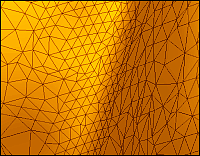|

Recording spatial qualities
by means of triangle networks
|
A more advanced method of 3D reconstruction is to define a
virtual model as a set of points in space (x,y,z coordinates) buildin a point
cloud; when these points are connected with each other, the surface is defined
by a large set of triangles (mesh file).
Such 3D files represent the surface of the object. Simple
models can be freely constructed, using special software, like 3D StudioMax. To
create a model of a complex object, the object´s geometry has to be captured by
a 3D recording device.
|